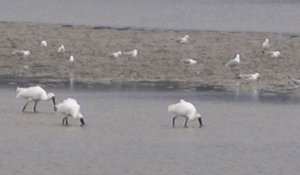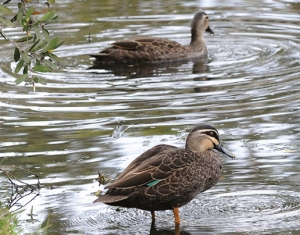Displaying items by tag: Australia
Australian invader
Yet another immigrant from Australia, royal spoonbills were known to Maori as kotuku ngutu papa so must have visited here for many years. Their numbers seem to have increased in the early 1940s. Some settled in the Waitangiroto River at Okarito. They have extended their range and now breed in a number of places, including Kapiti Island and Parengarenga and Manakau Harbours. There was a report of a colony up the Waiuku River. Royal spoonbills tend to breed near kotuku, shag and gull colonies. Some nests are high in kahikatea trees, others on low shrubs or on the ground. The birds assemble at nesting sites about October and begin their courting behaviour.
Spoonbills feed on insects, shellfish, small fish and frogs. They are readily identified in the distance by the way they feed, walking and sweeping their spoon bill in an arc, often knee deep in water. They feed day or night, whenever the tide is right.
Farewell shorebirds
BirdLife Australia and thousands of people across Australia were invited to farewell Australia’s amazing Shorebirds during April/May.
Every year from late March onwards, thousands of birds leave the shores of Australia to embark on their arduous 10,000km journey northwards to their breeding grounds in Siberia and the Arctic.
To celebrate this incredible journey, BirdLife Australia launched a nationwide event, Farewell Shorebirds, focusing on the fascinating lives of some of the 35 species of shorebirds.
Farewell Shorebirds ran from mid-April until mid-May, concluding on World Migratory Bird Day (May 10). This campaign highlighted the story of the shorebirds’ annual global migration from Australia to the Arctic, and explores why the birds make this incredible journey and how they rely on Australia’s wetlands, coastlines and estuaries for their survival in the landscape.
WetlandCare Australia discovery programme for primary schools
WetlandCare Australia launched their Wetland Discovery Programme last March, a curriculum-linked environmental teaching package for primary schools. It’s a practical and hands-on programme already proving to engage students in their local environment.
WetlandCare Australia, with the support of the National Australia Bank, has been working for 18 months to develop the Programme with Ocean Shores Public School as their test case.
“I’ve been amazed at the enthusiasm of students, teachers, parents and the broader community. It really is a programme they can all work together on, that is what makes it unique and effective” said Cassie Price, Regional Manager for WetlandCare Australia.
The Wetland Discovery Programme includes a kit for teachers and students with tailored lessons appropriate for each stage (1-3). The kit contains material that relates directly to a wetland in their local environment. “Even if there isn’t a wetland the students can access readily, most activities can still be undertaken without that element, but it is what makes it most relevant for the students, so it’s a key feature of the Programme” said Simone Haigh, Senior Project Officer for WetlandCare Australia.
WetlandCare Australia has assisted Ocean Shores Public School to get the most out of their Wetland Discovery Programme by installing a walking trail through their local wetland, with learning stations that relate to the Programme activities. Nest boxes with cameras and microscopes that can link back to the class interactive whiteboards have also added to the innovations.
The Wetland Discovery Teacher and Student kits are available as a free download from the WetlandCare Australia website. Those schools that want to take the Wetland Discovery Programme further than just the kit, with a trail, learning stations, nest boxes and more, are encouraged to get in touch with WetlandCare Australia for assistance in sourcing funding for additional resources.
Ducks in suburban Australia
A friend writes:
We have two duck ponds in our estate and the ducks are protected.
When Mum and Dad wander around the estate with their ducklings everyone gives them right of way. They know how protected they are:
When I first moved here with my cat Roxanne she watched mum and ducklings with dad on the end, wandering past my house.
She was about to pounce when father duck came charging over, flapping his wings and quacking as he attacked her. She has never challenged the ducks since. In fact she completely ignores them now!
I wish she would at least chase them away as they leave a lot of deposits on my driveway.
Some “quacking” information for you.



